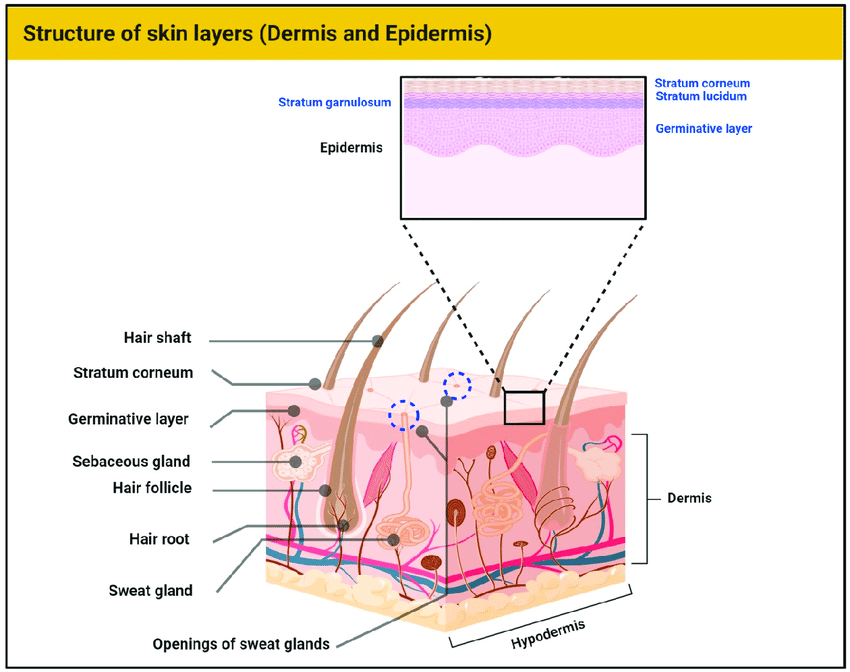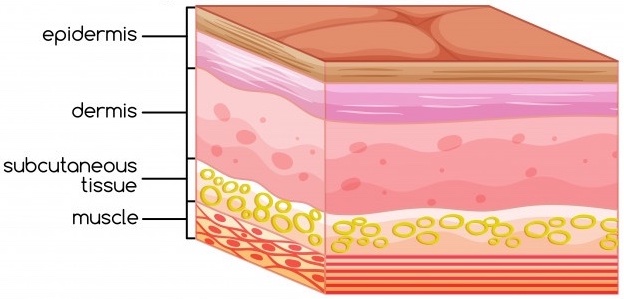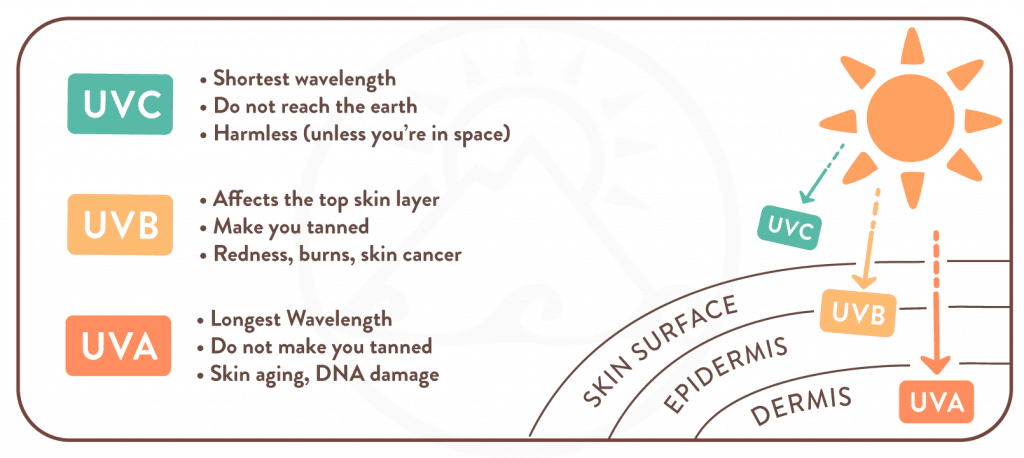The skin is the largest organ, and it's one of the most complicated. It's ever-changing, and it contains many specialized cells and structures. The skin's primary function is to serve as a protective barrier that interacts with a sometimes-hostile environment. It also helps regulate body temperature, gathers sensory information from the surrounding environment, and plays an active role in the immune system to protect the body from disease. Learning how the skin functions begins with an understanding of the structure of the three layers of skin: the epidermis, the dermis, and subcutaneous tissue.
the epidermis
The epidermis is the outermost layer of the three layers of skin. Its thickness depends on where it is located on the body. For example, it's thinnest on the eyelids (half a millimeter). It's thickest on the palms of the hands and soles of the feet (1.5 millimeters).
The epidermis contains three specialized cells:
• Melanocytes that produce pigment (melanin)
• Langerhans cells that act as the first line of defense in the skin's immune system
• Merkel cells that have a function that is not yet fully understood.
The epidermis acts as a barrier that protects the body from ultraviolet (UV) radiation, harmful chemicals, and pathogens such as bacteria, viruses, and fungi.

The Dermis
The dermis is the middle layer of the three layers of skin. It's located between the epidermis and the subcutaneous tissue. It contains connective tissue, blood capillaries, oil and sweat glands, nerve endings, and hair follicles.
The dermis is split into two parts—the papillary dermis, which is the thin, upper layer, and the reticular dermis, which is the thick, lower layer.
The thickness of the dermis varies depending on its location on the body. On the eyelids, it's 0.6 millimeters thick. On the back, the palms of hands, and the soles of feet it's 3 millimeters thick.
The dermis is home to three different types of tissues that are present throughout:
• Collagen
• Elastic tissue
• Reticular fibers.
The dermis contains several specialized cells and structures, including: Hair follicles; Sebaceous glands; Apocrine and endocrine glands; Blood vessels and nerve endings; Meissner corpuscles and lamellar corpuscles that transmit the sensations of touch and pressure.
The dermis is the thickest layer of skin and arguably the most important. It plays several key roles, including:
- Producing sweat and regulating the body's temperature: Within the dermis are sweat glands that produce sweat that comes out of the pores. The body sweats as a way to cool itself off, regulate temperature and flush out toxins. There are more than 2.5 million sweat glands in the body, and there are two different types: apocrine and eccrine. Apocrine sweat glands are found in the more odorous parts of the body, including the armpits, scalp, and genital region. The sweat glands, which become active during puberty, secrete their substances into the hair follicles. The sweat that is secreted is actually odorless at first. It only starts to smell when it comes in contact with skin bacteria. Eccrine sweat glands are located throughout the rest of the body—on the palms, the soles of feet, armpits, and the forehead. These glands emit their substances directly to the surface of the skin.
- Producing oil: The sebaceous glands produce sebum or oil. Sebum inhibits bacterial growth on the skin and conditions the hair and skin. If the follicle in which sebaceous glands are located becomes clogged with excess oil or dead skin cells, a pimple develops.
- Growing hair: Hair follicles are located in the dermis. Every follicle root is attached to tiny muscles, known as arrector pili muscles, that contract when the body becomes cold or scared, causing goosebumps.
- Feeling: The dermis is full of nerve endings that send signals to the brain about how things feel—whether something hurts, itches, or feels good.
- Distributing blood: Blood vessels are located in the dermis, which feeds the skin, removes toxins. and supply the epidermis with blood.
- Protecting the rest of the body: The dermis contains phagocytes, which are cells that consume potentially harmful toxins and impurities, including bacteria. The dermis already protects the body, but the phagocytes provide an additional layer of protection from anything harmful that has penetrated the epidermis.
- Giving the skin structure so it holds its shape: The dermal layer is responsible for the turgor of the skin, acting in a similar way as does the foundation of a building.

The Subcutaneous Tissue
Subcutaneous tissue is the deepest and innermost layer of the three layers of skin. It's mostly made up of fat, connective tissue, and larger blood vessels and nerves.
The thickness of this layer varies depending on where it's located on the body—for example, it's thickest on the buttocks, the soles of the feet, and the palms of the hands.
Subcutaneous tissue is a vital component of body temperature regulation. It also acts as a cushion, so if you ever fall or hit something with your body, it protects your insides and makes the injury hurt less.
Aging Process
There are several important changes in all three layers of our skin as we age.
The dermal layer becomes thinner with age as less collagen is produced. Elastin wears out—becoming less elastic just as the elastic waistband in a pair of shorts may lose its elasticity. This is what leads to wrinkling and sagging.

The sebaceous glands produce less sebum while the sweat glands produce less sweat, both contributing to the skin dryness characteristic of aging.
The surface area or amount of contact between the dermis and epidermis also decreases. This results in less blood being made available from the dermis to the epidermis and fewer nutrients making it to this outer layer of skin. This flattening out of the connecting region also makes the skin more fragile.
Wrinkles
Wrinkles, or rhytids, are lines, creases, and furrows in the skin. They develop as a normal part of the aging process as skin becomes thinner, dryer, slower to renew and repair itself, and is drawn downward by the pull of gravity. In women, hormonal changes associated with menopause further contribute to the development of wrinkles. The number and severity of wrinkles can be affected by lifestyle factors including sun exposure, smoking, and even repeated facial movements, which is why they're especially prominent on the face, especially around the eyes and mouth.
Over the course of a lifetime, skin is subjected to the impacts of aging, sun exposure, free radical damage, smoking, and repetitive movements of the facial muscles. All of these contribute to the development of wrinkles to varying degrees.

With age, the skin undergoes multiple changes that contribute to the development of wrinkles:
- Skin cells divide more slowly and the skin's middle layer, the dermis, becomes thinner.
- Collagen and elastin, protein fibers in the dermal layer that give skin its elasticity and shape, loosen and unravel, causing wrinkles on the skin surface.
- Fat diminishes in the subcutaneous tissue that makes up the deeper layers of the skin.
- Skin becomes less able to absorb and maintain moisture and the sebaceous glands produce less sebum (oil), causing skin to be dryer and exacerbating the appearance of wrinkles.
- Rete ridges, extensions of tissue that join the dermal and epidermal layers of the skin, flatten out, leaving skin fragile and conducive to shear wounds and wrinkles.
- Constricted blood vessels inhibit the flow of blood and oxygen to skin cells, which interferes with the skin's normal repair process.
- The pull of gravity over time loosens skin, causing it to sag and emphasizing the appearance of lines and wrinkles.
- In women, the decline in estrogen that occurs with menopause is accompanied by a decline in collagen as high as 30%.
FACIAL MOVEMENTS
Repetitive facial movements, such as frowning, squinting, and smiling cause tiny facial muscles to contract. Over time, these muscles don't relax, they stay contracted; this, coupled with the pull of gravity, contributes to wrinkles. These vary from tiny lines that extend vertically from the upper lip (smoker's lines) to deep crevasses between the eyes (frown lines) to nasolabial folds, which extend from the side of the nose to the corner of the mouth (laugh lines).
SUN EXPOSURE
Exposure to the sun's ultraviolet (UV) rays, both UVA and UVB rays, accounts for 90% of premature skin aging, or what's called photoaging. The severity of skin damage caused by the sun is determined by total lifetime exposure to UV rayes as well as skin color (pigment): The darker a person's skin the more natural protection they have from the effects of radiation.

Exposure to the sun affects the layers of the skin in different ways. It damages collagen fibers in the dermis and elastin fibers begin to accumulate at abnormal levels. This accumulation causes enzymes called metalloproteinases to be produced in large quantities. Typically, metalloproteinases repair skin by producing collagen, but sun damage causes them to malfunction and actually break down collagen, leading to the formation of fibers called "solar scars." As the skin repeats this imperfect rebuilding process over and over again, wrinkles develop.

FREE RADICALS
Free radicals are unstable oxygen molecules that alter the genetics of a cell and cause wrinkles and skin damage by activating the metalloproteinases that break down collagen. The smallest amounts of UV radiation, smoking, or exposure to air pollution can worsen this damage.
SMOKING
Smokers tend to experience premature wrinkles and their skin often appears dramatically older than that of people of the same age who do not smoke. Harmful chemicals in tobacco damage skin in a variety of ways, affecting elasticity, texture, color, and chemical makeup. One of these is by producing excess metalloproteinase.
In addition, the nicotine in cigarettes causes narrowing of the blood vessels in the outermost layers of skin, limiting the amount of blood, oxygen, and nutrients, such as vitamin A, that reach and nourish skin. The skin cells of smokers is slower to regenerate as well.
ANTI-AGING
From fine lines to deep furrows, skin wrinkles are an inevitable part of aging. Some people embrace, or at least accept, crow's feet, smile lines, and so forth as emblems of a life well-lived. Others don't. If you fall in the latter camp, you're probably aware of the many anti-aging skin products designed to reduce the appearance of wrinkles. A better approach to dealing with these and other signs of aging, though, is to begin taking steps to prevent them while you're young. While most of the changes in skin that cause wrinkles can't be avoided. lifestyle practices such as unprotected sun exposure, smoking, eating a diet low in nutrients, and not staying hydrated all can contribute to the early onset of wrinkles. The healthier your lifestyle is overall, the better able you'll be to stave off wrinkles and other signs of aging.
PROTECTION
Just as it's important to protect your epidermis from too much sun, it's important to protect your dermis as well. Sun exposure damages collagen (and causes changes in elastin), which can result in premature wrinkling.

